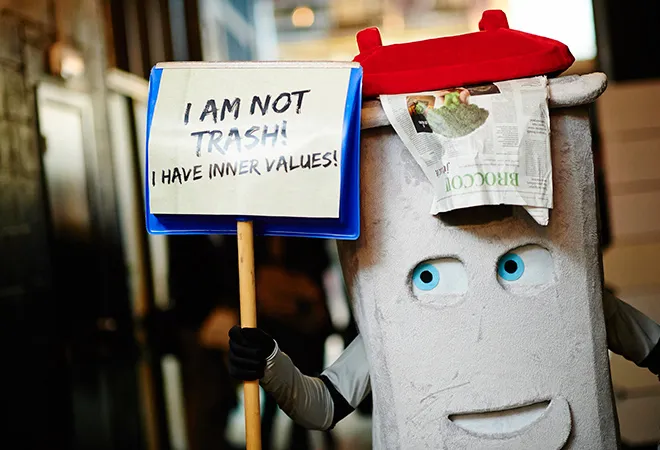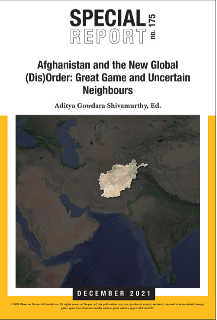
Between 1970 and 2015, India registered a six-fold increase from 1.18 billion to 7 billion tonnes in annual material consumption. By 2022, India will be the most populous nation in the world, and it’s expected that by 2030, its annual material consumption would double to 14.2 billion tonnes due to population growth, urbanisation, economic mobility, and the resulting growth in per-capita resource consumption. Currently, India’s resource extraction of 1,580 tonnes/acre is 251% higher than the world average of 450 tonnes/acre. While Europe recycles 70% of its consumption items, India recycles only 20%. India is also the third highest emitter of greenhouse gases, and accounts for 9.2% of total world emissions. Given that India aspires to become a global manufacturing hub, we would witness higher levels of consumption of raw materials, than what’s required to meet India’s domestic needs. Therefore, India’s traditional take-make-waste linear economic approach will cause severe ecological damage with untoward economic and social ramifications.
Maximised extraction of utility from raw materials, produced goods, and perishables, through-out their life-cycle, is central to building a circular economy. Given that India currently recycles only 20% of its consumption, there is enormous scope for improvements in this area, and this provides opportunity for innovation and employment. Hence the journey from the current linear economic model to a circular economic model is filled with both ecological and economic benefits. According to the
Ellen McArthur foundation, transitioning to a circular economy will result in US$ 624 billion in economic benefits, and reduce carbon emission by 44% (compared to current development path) in 2050 alone. As part of the sweeping economic reforms announced in the wake of the COVID-19 pandemic, the national government, in coordination with the state governments, must develop a roadmap for institutionalising a circular economic growth model for the nation.
Given that India currently recycles only 20% of its consumption, there is enormous scope for improvements in this area — and this provides opportunity for innovation and employment.
The journey towards building a circular economy needs a multi-pronged approach requiring the engaged participation of governments, industry and citizens. It needs a robust roadmap jointly owned and championed by the central, state, city and other local governments, and it must focus on the following aspects:
• Citizen awareness and source segregation — across the entire population
• Tax incentives and financing — to make investments in CE more financially viable
• Industry specific roadmap — to enable transition to CE based business and operating models in key industries
• Technological innovation — in technologies that make CE possible and viable
• Policy roadmap and coordination — between the national government, state governments, city governments, and industry
Citizen awareness and source segregation
With growing per-capita consumption, citizens need to be made aware of the ecological impact of their consumption pattern, which would nudge them to be responsible consumers. For example, to manufacture one kilogram of clothing, 27.6 kilograms of carbon dioxide is emitted; to manufacture a kilogram of computer parts, 96 kilograms of carbon dioxide is emitted. Just like how every food product has a mention of the calorific values of its contents, packaged products and pollution causing services such as airline travel must have a mention of the carbon foot print caused by the product/service consumption. In addition, school curriculums across India must educate children on the subject of circular economy and promote the ecological and environmental benefits of embracing a circular economic growth model.
India must also run a nation-wide sensitisation campaign emphasising on the importance of source-segregation of garbage at household level. A positive behavioral change towards source segregation of wet and dry waste is central to extracting the entire calorific value of wet waste, and recycling or extending the shelf-life of the dry waste that we discard. In India, 70% of waste goes untreated, and hence source segregation is a non-negotiable necessity to address the growing problem of landfills across
India.
School curriculums across India must educate children on the subject of circular economy and promote the ecological and environmental benefits of embracing a circular economic growth model.
Tax incentives and financing
The transition to a circular economy calls for significant investments in infrastructure and technology. Parts of these investments need to be made by state, city and local governments, and some need to be made by the private sector. In order to make such investments financially sustainable, the national government must fund the state, city and local governments that seek to build circular economies. Given that cities are central to building a circular economy, it must also be central to the union government’s Smart City Mission.
Special tax incentives must also be provided to make private sector firms increase their circular economy practices, and reduce their carbon foot print. For example, French car maker Renault uses 33% recycled materials in all its cars in Europe. If a car manufacturer in India produces such results, it must be provided appropriate tax breaks. In recognition of its superior ESG (Environment, Social, and Governance) models, ITC has been
ranked No.1 globally amongst its peers by Sustainalytics — a global ESG rating company. There are many companies such as ITC, Tata, Mahindra etc., which lay a lot of focus on ESG practices as part of its business strategy. Such companies must be financially incentivised to do more, and also to nudge other firms to adopt environmentally beneficial business practices.
Industry specific roadmap
India needs to develop an industry specific roadmap, targeting the ten industries that contribute heavily to environmental damage, while also offering the scope for significant improvements on adopting circular economy practices: transportation, food and agriculture, plastics, packaging, metals and minerals, cement, textiles, automobiles, electronics, and construction. Out of these, governments at various layers play a significant role in making the transportation industry more sustainable, by integrating it with the proper disposal of food and other forms of wet waste.
According to the
UN, 25% of the food produced in India is wasted. Wasted food could have been used to feed India’s several hungry citizens. Food that cannot be consumed contains significant calorific value that can be converted into energy. If collected in an organised fashion, other forms of wet waste (agricultural waste, market waste, etc.), along with food waste, could be converted into bio-CNG, which could be used to generate energy meant for fueling a part of the public transportation system. Many European cities such as
Stockholm operate such a public transportation model, and many others are gravitating towards introduction of bio-fuel powered city public transportation system in a big way. Given India’s massive food and agricultural waste generation, bio-fuel powered public-transportation systems can be institutionalised in India’s major cities, and this would yield significant environmental gains.
Integrating circular economy practices across the construction industry must be central to India’s housing and urbanisation roadmap.
It is estimated that 70% of the buildings in India, in 2050, are yet to be
built. Therefore, integrating circular economy practices across the construction industry must be central to India’s housing and urbanisation roadmap. Similarly, for every other industry, there is a strong business case and scope for integrating circular economy practices into their business and operational strategy. Developing and adhering to industry specific roadmaps can yield significant gains.
Technological innovation
In order to successfully transition to a circular economic model, there are many forms of digital, engineering and process technologies that need to be built and developed. While market forces will incentivise the development of digital technologies, the government must play a key role in promoting the development of engineering and process technologies required to build a circular economy. Across the ten polluting sectors, key engineering and process technologies that are central to developing a robust circular model of production must be identified and investments into their development must be funded and facilitated either directly by the government or through innovative models that attract private sector investments.
Policy roadmap and coordination
Systematic transition of India’s economy from a linear to a circular model calls for a strong policy roadmap, and coordination between various government layers involved in operationalising the roadmap. The central government must take the lead in this, and work closely with the various state, city and local governments in developing this comprehensive and implementation focused policy roadmap. Also, various other rules issued by the national government, such as the Plastic Waste Management Rules, E-waste Management Rules, Construction and Demolition Waste Management Rules, Metals Recycling Policy, etc., must be aligned with the national circular economy roadmap.
While the lockdown continues to cause significant economic slowdown, people in cities such as Jalandhar and Saharanpur could catch a glimpse of the Himalayan ranges after many decades due to reduction in air pollution. It was during the last three decades that the Indian economy registered significant growth, and this clearly establishes the unsustainable inverse relationship between ecological and economic welfare. Circular economic model of growth offers India the roadmap for making ecological and economic welfare complement and sustain each other. Many progressive
cities and
nations have embraced the strategic push towards building a circular economy. With many sweeping reforms being proposed to reverse the economic impact of the COVID-19 pandemic, it’s imperative that ecological welfare is not sacrificed at the altar of economic growth. Now is therefore the right time for institutionalising circular economic growth trajectory, such that it not only becomes a way of life across India’s economic spectrum, but also adequately prepares us to leverage its benefits as our population and per-capita consumption surges to unprecedented levels.
The views expressed above belong to the author(s). ORF research and analyses now available on Telegram! Click here to access our curated content — blogs, longforms and interviews.



 Between 1970 and 2015, India registered a six-fold increase from 1.18 billion to 7 billion tonnes in annual material consumption. By 2022, India will be the most populous nation in the world, and it’s expected that by 2030, its annual material consumption would double to 14.2 billion tonnes due to population growth, urbanisation, economic mobility, and the resulting growth in per-capita resource consumption. Currently, India’s resource extraction of 1,580 tonnes/acre is 251% higher than the world average of 450 tonnes/acre. While Europe recycles 70% of its consumption items, India recycles only 20%. India is also the third highest emitter of greenhouse gases, and accounts for 9.2% of total world emissions. Given that India aspires to become a global manufacturing hub, we would witness higher levels of consumption of raw materials, than what’s required to meet India’s domestic needs. Therefore, India’s traditional take-make-waste linear economic approach will cause severe ecological damage with untoward economic and social ramifications.
Maximised extraction of utility from raw materials, produced goods, and perishables, through-out their life-cycle, is central to building a circular economy. Given that India currently recycles only 20% of its consumption, there is enormous scope for improvements in this area, and this provides opportunity for innovation and employment. Hence the journey from the current linear economic model to a circular economic model is filled with both ecological and economic benefits. According to the
Between 1970 and 2015, India registered a six-fold increase from 1.18 billion to 7 billion tonnes in annual material consumption. By 2022, India will be the most populous nation in the world, and it’s expected that by 2030, its annual material consumption would double to 14.2 billion tonnes due to population growth, urbanisation, economic mobility, and the resulting growth in per-capita resource consumption. Currently, India’s resource extraction of 1,580 tonnes/acre is 251% higher than the world average of 450 tonnes/acre. While Europe recycles 70% of its consumption items, India recycles only 20%. India is also the third highest emitter of greenhouse gases, and accounts for 9.2% of total world emissions. Given that India aspires to become a global manufacturing hub, we would witness higher levels of consumption of raw materials, than what’s required to meet India’s domestic needs. Therefore, India’s traditional take-make-waste linear economic approach will cause severe ecological damage with untoward economic and social ramifications.
Maximised extraction of utility from raw materials, produced goods, and perishables, through-out their life-cycle, is central to building a circular economy. Given that India currently recycles only 20% of its consumption, there is enormous scope for improvements in this area, and this provides opportunity for innovation and employment. Hence the journey from the current linear economic model to a circular economic model is filled with both ecological and economic benefits. According to the  PREV
PREV


